
a.
To find the slope of the line joining two points.
a.
Answer to Problem 6PS
Explanation of Solution
Given information:
One of the fundamental themes of calculus is to find the slope of the tangent line to a curve at a point. To see how this can be done, consider the point
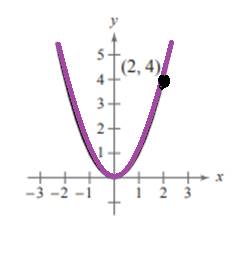
Find the slope of the line joining
Here, we will consider a point
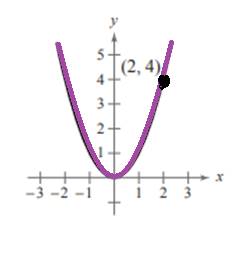
We will first differentiate the function
Now, the slope of the tangent line at point
As we know that, the slope of the line passing through the points
Hence, the slope of the line passing through the points
Hence, the slope of the tangent line at point
b.
To find the slope
b.
Answer to Problem 6PS
Explanation of Solution
Given information:
One of the fundamental themes of calculus is to find the slope of the tangent line to a curve at a point. To see how this can be done, consider the point
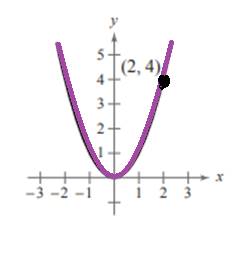
Find the slope
Calculation:
The slope of the line passing through the points
Hence, the slope of the tangent line at point
c.
To find the slope
c.
Answer to Problem 6PS
Explanation of Solution
Given information:
One of the fundamental themes of calculus is to find the slope of the tangent line to a curve at a point. To see how this can be done, consider the point
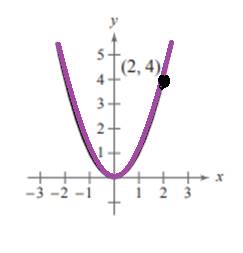
Find the slope
Calculation:
The slope of the line passing through the points
Hence, the slope of the tangent line at point
d.
To find the slope
d.
Answer to Problem 6PS
Explanation of Solution
Given information:
One of the fundamental themes of calculus is to find the slope of the tangent line to a curve at a point. To see how this can be done, consider the point
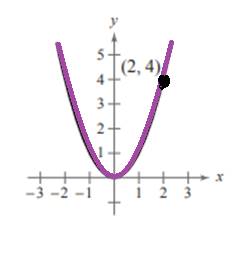
Find the slope
Calculation:
The slope of the line passing through the points
Hence, the slope
e.
To evaluate the slope formula.
e.
Answer to Problem 6PS
For
For
For
Explanation of Solution
Given information:
One of the fundamental themes of calculus is to find the slope of the tangent line to a curve at a point. To see how this can be done, consider the point
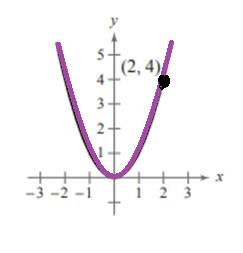
Evaluate the slope formula from part
Calculation:
For
For
For
Hence, the slope gives the same values as we get in parts
f.
To write the conclusion about the slope
f.
Answer to Problem 6PS
The slope of the tangent line at point
Explanation of Solution
Given information:
One of the fundamental themes of calculus is to find the slope of the tangent line to a curve at a point. To see how this can be done, consider the point
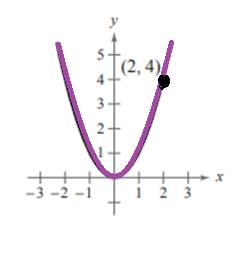
What can you conclude the slope
Calculation:
Now, from the slope formula
Chapter 2 Solutions
EBK PRECALCULUS W/LIMITS
- #2arrow_forward2. We want to find the inverse of f(x) = (x+3)² a. On the graph at right, sketch f(x). (Hint: use what you know about transformations!) (2 points) b. What domain should we choose to get only the part of f (x) that is one- to-one and non-decreasing? Give your answer in inequality notation. (2 points) - c. Now use algebra to find f¯¹ (x). (2 points) -4- 3- 2 1 -4 -3 -2 -1 0 1 -1- -2- --3- -4 -N- 2 3 4arrow_forward1. Suppose f(x) = 2 4 == x+3 and g(x) = ½-½. Find and fully simplify ƒ(g(x)). Be sure to show all x your work, write neatly so your work is easy to follow, and connect your expressions with equals signs. (4 points)arrow_forward
- Find the one sided limit Tim f(x) where f(x)= (2x-1 X>1+ *arrow_forwardFind the limit lim X-700 4 13x-15 3x4+x³-12arrow_forwardFind the slope of the line secant to the curve F(x) = 13-x³ (from x=1 to x=2]arrow_forwardFind the ONe sided limit lim 2x X-2 1-xarrow_forwardFor each function, identify all points of discontinuity and label them as removable, jump, or infinite. A) f(x) = x-4 (X+15)(x-4) B) f(x) = (x²-1 x ≤2 14-2x 2arrow_forwardFind the one sided limit 2 lim Flx) where f(x) = (x²-4_xarrow_forwardarrow_back_iosSEE MORE QUESTIONSarrow_forward_iosRecommended textbooks for you
 Calculus: Early TranscendentalsCalculusISBN:9781285741550Author:James StewartPublisher:Cengage Learning
Calculus: Early TranscendentalsCalculusISBN:9781285741550Author:James StewartPublisher:Cengage Learning Thomas' Calculus (14th Edition)CalculusISBN:9780134438986Author:Joel R. Hass, Christopher E. Heil, Maurice D. WeirPublisher:PEARSON
Thomas' Calculus (14th Edition)CalculusISBN:9780134438986Author:Joel R. Hass, Christopher E. Heil, Maurice D. WeirPublisher:PEARSON Calculus: Early Transcendentals (3rd Edition)CalculusISBN:9780134763644Author:William L. Briggs, Lyle Cochran, Bernard Gillett, Eric SchulzPublisher:PEARSON
Calculus: Early Transcendentals (3rd Edition)CalculusISBN:9780134763644Author:William L. Briggs, Lyle Cochran, Bernard Gillett, Eric SchulzPublisher:PEARSON Calculus: Early TranscendentalsCalculusISBN:9781319050740Author:Jon Rogawski, Colin Adams, Robert FranzosaPublisher:W. H. Freeman
Calculus: Early TranscendentalsCalculusISBN:9781319050740Author:Jon Rogawski, Colin Adams, Robert FranzosaPublisher:W. H. Freeman
 Calculus: Early Transcendental FunctionsCalculusISBN:9781337552516Author:Ron Larson, Bruce H. EdwardsPublisher:Cengage Learning
Calculus: Early Transcendental FunctionsCalculusISBN:9781337552516Author:Ron Larson, Bruce H. EdwardsPublisher:Cengage Learning
 Calculus: Early TranscendentalsCalculusISBN:9781285741550Author:James StewartPublisher:Cengage Learning
Calculus: Early TranscendentalsCalculusISBN:9781285741550Author:James StewartPublisher:Cengage Learning Thomas' Calculus (14th Edition)CalculusISBN:9780134438986Author:Joel R. Hass, Christopher E. Heil, Maurice D. WeirPublisher:PEARSON
Thomas' Calculus (14th Edition)CalculusISBN:9780134438986Author:Joel R. Hass, Christopher E. Heil, Maurice D. WeirPublisher:PEARSON Calculus: Early Transcendentals (3rd Edition)CalculusISBN:9780134763644Author:William L. Briggs, Lyle Cochran, Bernard Gillett, Eric SchulzPublisher:PEARSON
Calculus: Early Transcendentals (3rd Edition)CalculusISBN:9780134763644Author:William L. Briggs, Lyle Cochran, Bernard Gillett, Eric SchulzPublisher:PEARSON Calculus: Early TranscendentalsCalculusISBN:9781319050740Author:Jon Rogawski, Colin Adams, Robert FranzosaPublisher:W. H. Freeman
Calculus: Early TranscendentalsCalculusISBN:9781319050740Author:Jon Rogawski, Colin Adams, Robert FranzosaPublisher:W. H. Freeman
 Calculus: Early Transcendental FunctionsCalculusISBN:9781337552516Author:Ron Larson, Bruce H. EdwardsPublisher:Cengage LearningFundamental Theorem of Calculus 1 | Geometric Idea + Chain Rule Example; Author: Dr. Trefor Bazett;https://www.youtube.com/watch?v=hAfpl8jLFOs;License: Standard YouTube License, CC-BY
Calculus: Early Transcendental FunctionsCalculusISBN:9781337552516Author:Ron Larson, Bruce H. EdwardsPublisher:Cengage LearningFundamental Theorem of Calculus 1 | Geometric Idea + Chain Rule Example; Author: Dr. Trefor Bazett;https://www.youtube.com/watch?v=hAfpl8jLFOs;License: Standard YouTube License, CC-BY